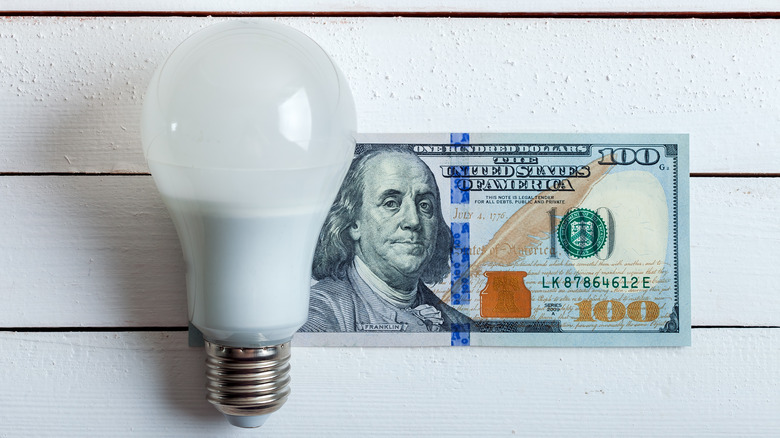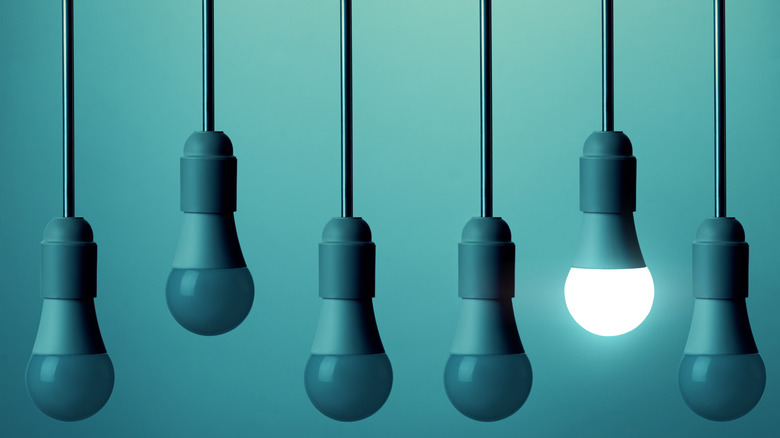The Biggest Downside Of LED Lights (And 5 Reasons They're Better Than Incandescent)
You may have considered a switch to LED lighting but are unsure what difference it will make. The lighting system has many significant advantages over traditional lighting methods. Incandescent bulbs use a filament to generate light. This filament has a lot of electrical resistance, so passing a current through it causes it to heat up and eventually glow. The heat created by this process is just wasted energy. LEDs don't have a filament. Instead, it contains a semiconductor material that produces light as electricity is passed through it. This difference is key to many of an LED light's advantages.
But there is also a downside: the price tag. It's often significantly cheaper to pick up an incandescent bulb than it is to buy an LED. Bulbs from known brands, particularly bright options or those packing plenty of features, will cost even more than basic models. You may find yourself dropping over $20 on a single light. Given that an entire house has one or more lights per room, making the switch all at once might be a pricey endeavor.
However, some power companies offer subsidies to make the price of LED bulbs more appealing. They are also frequently on sale on websites like Amazon, and some sites have offerings as cheap as $1 a pop. Factor in a few other savings, some of which we'll discuss below, and an LED bulb may actually work out hundreds of dollars cheaper than what you currently have.
They are cheaper to run
One of the better-known facts about LEDs relates to their power consumption. Due to the fact they use a semiconductor instead of a filament, the bulbs require far less energy to run. Some bulbs only use around a tenth of the power an incandescent bulb of the same brightness needs. A tenth of the power.
While any kind of consumer lightbulb is unlikely to make a huge difference to your monthly power bill, the savings over the course of a bulb's lifetime can be significant. According to the U.S. Government, the average American household will save around $225 per year if it switches to LED lighting.
Given that an LED bulb can last 10 to 15 years, the switch is likely to save you thousands of dollars in the long run. Factor in the lifespan of the bulbs when compared to incandescent lighting and potential subsidies in place to help you switch, and changing out your bulbs becomes a very cheap upgrade. From a purely financial standpoint, the switch to LED is an absolute no-brainer.
LED bulbs can be brighter
A major limiting factor when it comes to household lighting is the amount of wattage your circuitry can take. Traditionally, 100 watts is about as much lightbulb as you could cram into most fittings, and seeing lamps that could only handle around 60 watts was not uncommon. All wires have some degree of resistance, and using a bulb that would pull more electricity than the wires and fittings in the system are rated for can result in fires, melting, and shorting.
Even if your wires can handle it, each circuit in your house can only manage so much. This is why it's easy to trip your circuit breaker if you plug too many demanding kitchen appliances into the same outlet. Lights tend to be on their own circuits, but that circuit will still have its safe limit.
Another factor for brightness potential is the amount of heat generated. In this case, heat is wasted energy, and it's where 90% of the power you put into an incandescent bulb goes. An LED pumping out an equivalent amount of light to a conventional 300-watt bulb will only use just over a tenth of the current the incandescent option will need. That amount of current going through an incandescent bulb, assuming your house's wiring and light fittings can take it, will create a lot of heat.
To put it into context, a pre-2007 easy-bake oven uses a 100-watt bulb to heat the mixtures that are placed into it. A 300-watt lightbulb will generate significantly more heat than that and will likely make things unpleasant for anyone sitting close to it. With an LED, you get the same amount of light, and there is little risk of accidentally cooking something.
LED bulbs will last longer
Changing a lightbulb isn't a difficult task. It's so simple that it's been the basis of a genre of jokes that have probably been around since British chemist Joseph Swan hooked up the first incandescent bulb in February of 1879. Despite its simplicity, it's still a household chore that can be easily avoided by switching to LED. So you'll spend a little less time looking for something dangerous to stand on, or muttering curse words when the flick of a light switch is greeted with a flash, that little clinking sound, and an inconvenient level of darkness.
Some LEDs can last over 10 years before finally calling it a day — with higher-end options rated for 100,000 hours of use or more. Incandescent bulbs, by comparison, last between 1,000 and 5,000 hours on average. So if a cheaper LED lasts 50,000 hours, and an incandescent bulb lasts 5,000 in a best-case scenario, that's still 10 bulbs you'll need to purchase and install compared to one LED. At the other extreme, a single LED could outlast 100 incandescent bulbs — which translates to significant savings in cost and personal labor.
The bulbs are better for the environment
LED bulbs are a greener choice for a few reasons. As they require less power to produce light and last far longer than conventional bulbs, LED bulbs tend to be better for the environment than their incandescent options. The DEC estimates that some low-energy bulbs, like LEDs, can use as much as 90% less electricity than incandescent bulbs. Power generation is one of the most significant contributors to global emissions. If lighting currently accounts for 15% of the average power bill, the switch to LEDs alone could reduce the demand for electricity in the U.S. by 13.5%.
The bulb's long lifespans also make them a better choice environmentally. Yes, LED bulbs are usually made from plastic, but incandescent bulbs aren't much better. Creating glass is energy-intensive, and many types of light bulbs are hard to recycle. As a result, not many people bother, and the majority end up in a landfill. If you stumble across an older bulb, it could also contain hazardous materials like mercury. Given the difference in lifespans, sticking with incandescent bulbs is likely to produce far more waste than opting for an LED light.
LED bulbs are far more versatile
An LED bulb is a far more versatile option and ideal for people with a smart home or individuals who want more color in their lives. The nature of the LED itself, coupled with other technology within the bulbs, means things like brightness, tone, and color are often customizable. Lights can also be connected to an app or home network and controlled remotely or set to a timer with ease.
You can technically do all of these things with an incandescent bulb, but it's far more complex and requires extra equipment. For example, connecting an incandescent bulb to a smart home network requires you to connect a smart plug to your lamp or fit a smart switch in the case of a light fixture. You may also have to look for dimmer switches, which require specialist bulbs or certain lamps to get the effect you want. In terms of colors, incandescent bulbs tend to produce a bright yellow light and nothing else. This means you have to alter the bulb's glass or use some kind of lens if you want to change the color.
So if you find plain white light boring and want to brighten up your dwelling in a creative manner, LED is both more convenient and significantly cheaper. Skeptics who find the light LEDs emit to be too bright and a bit "clinical" can shop for bulbs that can produce a "color temperature" of around 2,700 Kelvin. This should give you a similar effect to a standard tungsten filament lightbulb.





